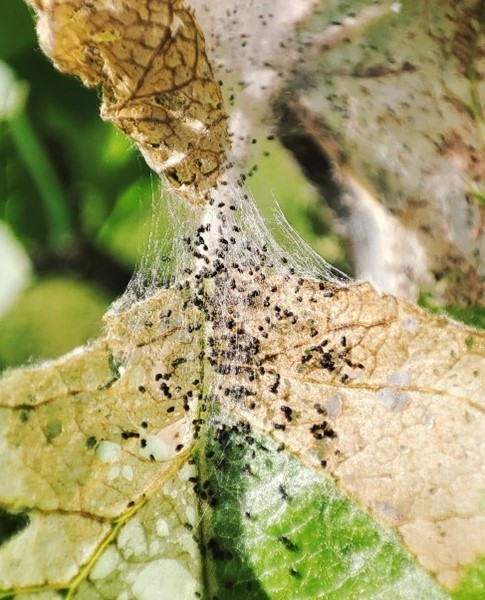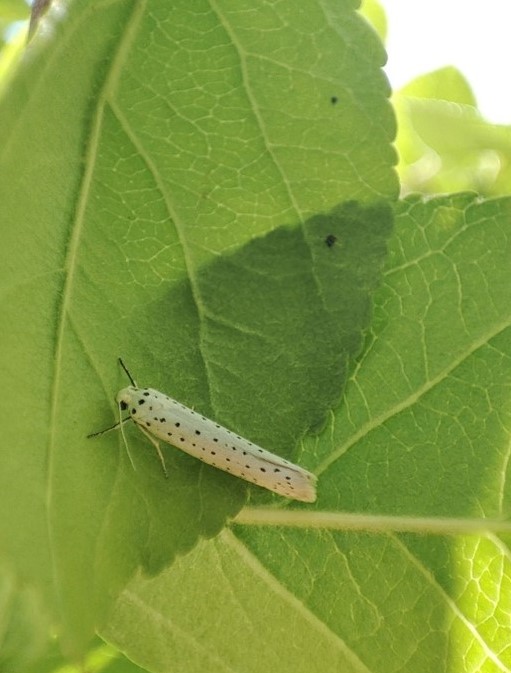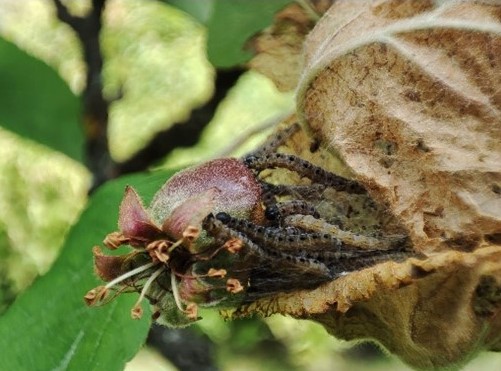Identification and management of Tent caterpillars (Malacosoma sp.) in apple trees
Apples are high-value crops that have been cultivated globally. Their importance for the human diet can be reflected by proverbs such as: “An apple a day keeps the doctor away.” While apple trees that have been treated appropriately can yield 150-300 apples per tree on average. However, pests like tent caterpillars can put apples’ health and production at risk. This pest is considered to be the most devastating lepidopteran pest. The name tent caterpillars come from the nature of larvae that spins nets around the place where they feed. Most commonly found are western, eastern, and forest tent caterpillars (1). The species differ in region and habitat, but they are cosmopolitan and can feed on various crops and defoliate them quickly. Wild cherry and apple are the most damage-prone crops. They also cause damage to pears, plums, roses, peaches, poplar, etc.
Many trees have been defoliated, so combating this pest is a huge challenge for growers and researchers around the globe.
The life cycle of Tent caterpillars (Malacosoma sp.)
Eggs- The winter is spent as egg masses encircling twigs (2). The eggs are covered with a protective material with a jelly-like dark-colored coating (1). Larvae hatch in early spring. This time coincides with the unfolding of leaves.
Larvae– After a few days, the larvae start forming a tent, and the size of the tent/net grows as the larvae mature. For feeding the leaves, the larvae leave the tent and start feeding on young leaves in the early larval stage. The larvae prefer to feed in groups within a silken tent. Larvae are active during the daytime (1) (Figure 1). They can also attack fruits upon maturation, as shown in the Figure.
After feeding, they return to the tent (2). In the tent, the excreta of the larval populations can be seen in the image. The larvae can grow a couple of inches long. The caterpillars go through five instars (growth stages) before pupation. They tend to split into smaller groups and move to new sites for feeding (3).
Even though the larvae can defoliate the twigs and branches fast, they are not generally able to kill the plant (2). Special attention must be given to young plants and trees or in nurseries.
Pupa– Pupation starts after reaching mature (4-6 weeks) larval stage. They pupate inside whitish-colored cocoons on tree trunks or fences. Pupation generally takes 3-4 weeks.
Adult– After pupation is over, adults emerge from cocoons. After emergence, mating occurs, and females start laying eggs, and the cycle continues. There is only one generation per year of tent caterpillars. Adults are white with black strips on their wings (Figure 5).


Figure 1. Larvae feeding in groups during day time.

Figure 2. Tent with only excreta. The larva moved to the next destination to feed after feeding here.

Figure 3. Defoliated leaves showing excreta of larva along with damaged fruit.

Figure 4. Adult Moth of tent caterpillar
How to control-manage the tent caterpillars – Integrated Management practices for tent caterpillars in apple trees
Precautionary measures
Prevention is the one thing grower should focus on. Careful observation of egg masses in fruit orchards and destroying them could lower the population in summer. During early summer, small tents seen during field monitoring could be destroyed. Pruning in heavily infested branches has been effective, especially in the early mornings, as they tend to stay together at night. For trapping adults, light traps could be used.
Inspection of trees during winter pruning for egg masses can lower the potential damage.
Biological control
Avoid monoculture: Monoculture means planting the same species and varieties over a vast land area for several years. In nature, we can find a large diversity of plant species growing in an area. So, monoculture makes it very easy for caterpillars to move from adjacent trees, and nothing prevents them from moving. In other words, monoculture helps harbor pests and diseases by bringing them the food and the environment it desires.
Thus, redesigning the orchard by mixing species, for example, with pears or plums or even different varieties of apples, can help infestation of diseases and crops in apples. The incorporation of some nitrogen-fixing crops during the mixing of species could be a great tool.
Natural enemies of tent caterpillars
Predators– Birds, spiders, and insects like beetles and ants are important predators.
Parasitoids– simply, parasitoids are small insects that develop within or are attached outside of the host insects and eventually kill them. They are used as a biocontrol management option. So, several parasitoids have been used for the management of tent caterpillars. An efficient parasitoid is the Tachinid fly.
Application of Bacillus thuringiensis var. kurstaki during the early larval instar stage is effective4 5. Neem (Azadirachtin) based solution can be sprayed in alternation with other biocontrol options. Metarhizium brunneum and Beauveria bassiana isolates were found to be effective for larval control and could be a potential biocontrol option 6. The use of these organisms offers safety and environment-friendly management. Tents reduce the efficacy of sprays if the tents are not opened.
Chemical control
Application of chemical insecticides should be made by following the necessary precautions and after consulting a licensed, local agronomist or an extension center. Chemical insecticides are effective during early larval instars when the level of damage is not so severe. Activities of natural enemies should be considered while spraying.
Notes: All the pictures were taken by the author himself in 2022 at Luke, Finland.
References
- Antosh, G. How To Get Rid Of Tent Caterpillars [DETAILS]. Plant Care Today https://plantcaretoday.com/tent-caterpillar.html (2018).
- Tent Caterpillars | Entomology. https://entomology.ca.uky.edu/ef424.
- Apple-Tent caterpillar. Pacific Northwest Pest Management Handbooks https://pnwhandbooks.org/insect/tree-fruit/apple/apple-tent-caterpillar (2015).
- Tent Caterpillars in Orchards. Philadelphia Orchard Project https://www.phillyorchards.org/2015/06/08/tent-caterpillars-in-orchards/.
- Waterworth, K. Tent Caterpillars in an Apple Tree. Weekand https://www.weekand.com/home-garden/article/tent-caterpillars-apple-tree-18042941.php (2012).
- Topkara, E. F., Yanar, O., Sahin, F., Yanar, Y. & Yanar, D. Efficacy of Metarhizium brunneum and Beauveria bassiana isolates against the European tent caterpillar, Malacosoma neustria Linnaeus, 1758 (Lepidoptera: Lasiocampidae). Egypt. J. Biol. Pest Control 32, 89 (2022).









































































